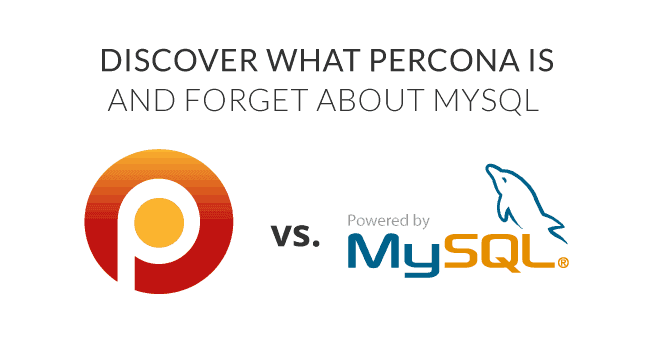Percona, what is it and why you should forget about MySQL for good.
What is Percona?
Let’s start at the very beginning, what is Percona? Percona Server started out as a fork of MySQL that promised from the beginning to provide a platform of greater performance and scalability. Today Percona is an organization that, with the Percona Server’s main product, offers a significant amount of free software, advisory services and technical service.
When we think about installing the Percona Server we must necessarily go back to an old dilemma: install the fork of a system or remain faithful to the original project.
When solving this dilemma, it is necessary to specify what the Percona Server is, what the orientation of the project that goes with it is and what Percona as a company has to offer.
Below is a review, which clarifies these points and supports the decision to introduce us to a migration process to Percona and ultimately forget about MySQL.
Full compatibility with MySQL
From its origins the Percona Server has maintained 100% compatibility with MySQL, so that all the functionality of MySQL can be found in the Percona Server, this ensures seamless migration processes which can be assumed progressively.
Percona as a company, has maintained the strategy of equating its product, not with the GPL (General Public License) version of MySQL, but with its commercial version (Enterprise Edition). Now you know that with Percona, we will get the same advantages on the free Server as the ones that we get by paying in MySQL.
Likewise, Percona maintains the other tools developed around its fundamental product as free software, such as the XtraDB Cluster and the XtraDB Backup. So if we go for the Percona Server and then we want to increase the size of the database and scale our entire platform to a higher level or we decide to undertake a project of hot backups, we are sure that we will continue in the free software world.
Another interesting aspect is that the versions of the Percona Server maintain a direct correspondence with the versions of MySQL, so the version 5.7.10 of the Percona Server corresponds to the improvements made on MySQL version 5.7.10. This may seem, at first, a not very important element but actually it facilitates the planning process of migration from MySQl to Percona as well as the problem solving of a particular problem in an installation .
Performance Improvement Orientation
Based on its full compatibility with MySQL, Percona has maintained a firm position towards improving the performance of its products. Here we can highlight the XtraDB piece which is an improved version of the InnoDB engine used by MySQL.
XtraDB has fundamental elements of InnoDB as the concurrency control MVCC (Multiversion Concurrency Control) and ACID properties (Atomicity, Consistency, Isolation and Durability), and it introduces constant improvements with the aim of allowing and facilitating the intonation of the engine in order to improve the performance of the entire system.
Different versions of Percona XtraDB have introduced tools and procedures aimed at identifying and correcting containment problems, which may sound very ambitious given that containment can occur on several levels and intermittently.
However, the procedures for identifying containment in the buffer pool are interesting because of the mutual exclusion scheme. In Cache memory due to the size definitions, or again in the buffer pool but this time by the schema of data placement in a multi-node environment.
At this point we could finish by saying that by introducing ourselves to the world of the Percona Server, we would be entering an environment where all our intonation efforts are supported and empowered in order to improve our applications.
Scalability Orientation
Based on XtraDB, Percona introduced the free software product called XtraDB Cluster that allows the creation, management and monitoring of Cluster of several servers, the Percona Server or MySQL. This way, offering an answer to the scalability requirements of those installations that increase their number of transactions, either by a natural increase of the business or by a one-time increase, such as a marketing plan.
A cluster configured with Percona XtraDB Cluster allows the inclusion of three or more servers, called nodes in a single logical structure where all of them have all the data and the same capabilities of reading and writing.
These clusters ensure that a query will be solved by any of the servers without requiring a remote access, and in the event that a node is lost or failed for any reason, the cluster will continue to operate without loss of data, consistencies or suspension of the service for the final users.
Orientation to the management and monitoring of Database
At the beginning of this century we had a MySQL that had few management tools and by 2011 Percona introduced the Percona Toolkit, allowing us to find redundant indexes in order to compare the configuration of two servers, through the introduction of intended delays in master – slave replication.
It is true that MySQL reacted and improved its MySQL utilities, but Percona since its inception has promoted the enrichment of its group of database management tools.
Another important aspect is the ability to monitor and obtain statistics on the operation of the database, considering a very broad set of variables that include the very valuable performance counters per table, index and user.
Customer service
Last but not least, the service that Percona offers its clients ranges from technical service and advice to the management of the entire database system by Percona, of course under an economic outlay.
They offer very flexible maintenance contracts that can support even NoSQL elements in 24x7x365 service hours and with service agreements (SLAs) that can include even a economic compensation.
Lastly, with more than three thousand customers worldwide this element is a strong point of Percona as a company and a very strong support for the Server and the rest of its products.
So this is ‘’what Percona is and why you should forget about MySQL’’, if you liked this article, do not forget to visit our blog and the Pandora FMS website.
About Pandora FMS
Pandora FMS is a flexible monitoring system, capable of monitoring devices, infrastructures, applications, services and business processes.
Of course, one of the things that Pandora FMS can control is the hard disks of your computers.
Would you like to know more about what Pandora FMS can offer you? Discover it by entering here: https://pandorafms.com
If you have more than 100 devices to monitor, you can contact us through the following form: https://pandorafms.com/en/contact/
Also, remember that if your monitoring needs are more limited you have at your disposal the OpenSource version of Pandora FMS. Find more information here: https://pandorafms.org
















